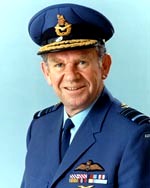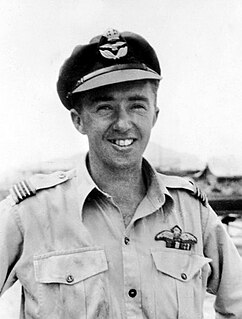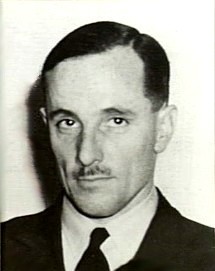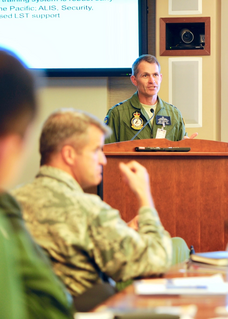Related Research Articles

Air Marshal Geoffrey David Shepherd is a retired senior officer in the Royal Australian Air Force (RAAF), who served as Chief of Air Force from 2005 until 2008.

Air Marshal Sir James Anthony (Jim) Rowland, was a senior commander in the Royal Australian Air Force (RAAF), serving as Chief of the Air Staff (CAS) from 1975 to 1979. He held office as Governor of New South Wales from 1981 to 1989, and was Chancellor of the University of Sydney from 1990 to 1991.
Chief of Air Force (CAF) is the most senior appointment in the Royal Australian Air Force (RAAF), responsible to the Chief of the Defence Force (CDF) and the Secretary of the Department of Defence. The rank associated with the position is air marshal (three-star). The role encompasses "the delivery of aerospace capability, enhancing the Air Force's reputation and positioning the Air Force for the future". It does not include direction of air operations, which is the purview of the Air Commander Australia, a two-star position responsible directly to CDF in such circumstances but nominally reporting to CAF.

Air Chief Marshal Sir Neville Patrick McNamara, was a senior commander of the Royal Australian Air Force (RAAF). He served as Chief of the Air Staff (CAS), the RAAF's highest-ranking position, from 1979 until 1982, and as Chief of the Defence Force Staff (CDFS), Australia's top military role at the time, from 1982 until 1984. He was the second RAAF officer to hold the rank of air chief marshal.
Air Vice Marshal Alfred John Quaife, AM is a retired senior officer of the Royal Australian Air Force (RAAF).
Air Vice Marshal Julie Hammer, is an Australian engineer and a retired senior officer in the Royal Australian Air Force (RAAF). She was the first woman to be promoted to one-star rank, and also the first woman to be promoted to two-star rank, in the Australian Defence Force. She was also the first woman to command an operational unit in the RAAF.

Air Vice-Marshal Joseph Eric Hewitt, CBE was a senior commander in the Royal Australian Air Force (RAAF). A Royal Australian Navy officer who transferred permanently to the Air Force in 1928, he commanded No. 101 Flight in the early 1930s, and No. 104 (Bomber) Squadron RAF on exchange in Britain shortly before World War II. Hewitt was appointed the RAAF's Assistant Chief of the Air Staff in 1941. The following year he was posted to Allied Air Forces Headquarters, South West Pacific Area, as Director of Intelligence. In 1943, he took command of No. 9 Operational Group, the RAAF's main mobile strike force, but was controversially sacked by the Chief of the Air Staff, Air Vice Marshal George Jones, less than a year later over alleged morale and disciplinary issues.

Air Vice Marshal Francis Masson (Frank) Bladin, was a senior commander in the Royal Australian Air Force (RAAF). Born in rural Victoria, he graduated from the Royal Military College, Duntroon, in 1920. Bladin transferred from the Army to the Air Force in 1923, and learned to fly at RAAF Point Cook, Victoria. He held training appointments before taking command of No. 1 Squadron in 1934. Quiet but authoritative, he was nicknamed "Dad" in tribute to the concern he displayed for the welfare of his personnel.

Air Vice Marshal Ellis Charles Wackett, CB, CBE was a senior commander in the Royal Australian Air Force (RAAF). Its chief engineer from 1935 to 1959, he served on the RAAF's controlling body, the Air Board, for a record seventeen years, and has been credited with infusing operations with new standards of airworthiness. Commencing his service career as a Royal Australian Navy cadet during World War I, Wackett transferred to the Air Force in 1923 while on an engineering course in Britain. He qualified as a pilot before completing his studies and returning to Australia, where he inaugurated parachute instruction within the RAAF and made the country's first freefall descent from a military aircraft in 1926. The following year, he led a three-month survey flight to Papua New Guinea.

Air Marshal John William "Jake" Newham, AC is a retired senior commander of the Royal Australian Air Force (RAAF). He served as Chief of the Air Staff (CAS) from 1985 until 1987. Joining the RAAF in 1951, he flew Gloster Meteor jets with No. 77 Squadron in the Korean War in 1953, and subsequently de Havilland Vampires with No. 78 Wing on garrison duty in Malta. From 1958 to 1960, he served with No. 3 Squadron, operating CAC Sabres during the Malayan Emergency. He took charge of No. 3 Squadron in 1967, when it re-equipped with the Dassault Mirage III supersonic fighter. His commands in the early 1970s included the Aircraft Research and Development Unit, RAAF Base Laverton, and No. 82 Wing, the last-mentioned during its first years operating the long-delayed General Dynamics F-111C swing-wing bomber. He was appointed Deputy Chief of the Air Staff in March 1984, and CAS in May the following year. His tenure as CAS coincided with the release of the Dibb Report on Australia's defence capabilities, and the controversial transfer of the RAAF's battlefield helicopters to the Australian Army. Newham retired from the Air Force in July 1987 and became a company director.
Air Marshal Raymond George (Ray) Funnell, is a retired senior commander of the Royal Australian Air Force (RAAF). He served as Chief of the Air Staff (CAS) from 1987 until 1992. A graduate of RAAF College, he began his career flying CAC Sabre jet fighters in Australia and South East Asia in the 1950s and 1960s. From 1972 to 1975 he commanded No. 6 Squadron, during which time the General Dynamics F-111C swing-wing bomber entered Australian service. He held senior staff posts in the early 1980s. In 1986, he was promoted to air marshal and became the inaugural Vice Chief of the Defence Force. Appointed CAS in July 1987, Funnell was closely involved in the development and dissemination of air power doctrine. He retired from the RAAF in October 1992 following his term as CAS, and was founding Principal of the Australian College of Defence and Strategic Studies from 1994 to 1998. Since then he has served on various Federal Government committees on immigration and detention.
Air Marshal Douglas John Stuart Riding, is a retired senior Royal Australian Air Force commander and a former Vice Chief of the Defence Force.

Air Marshal Melvin Ernest Glanville Hupfeld, is a retired senior officer of the Royal Australian Air Force. He served as Air Commander Australia from 2012 to 2014 and was the acting and final Chief Capability Development Group (2015–16), before being appointed as Head Force Design in the Vice Chief of the Defence Force Group (2016–18). He was promoted air marshal and made Chief of Joint Operations in May 2018, and succeeded Air Marshal Leo Davies as Chief of Air Force in July 2019.
Air Vice Marshal Margaret Mary Staib, is a former Chief Executive Officer of Airservices Australia and a former senior officer in the Royal Australian Air Force (RAAF).

Air Marshal Gavin Neil "Leo" Davies, is a retired senior officer of the Royal Australian Air Force (RAAF). A navigator who retrained as a pilot, he joined the RAAF in 1979, commanded No. 1 Squadron RAAF (2002–03) and No. 82 Wing RAAF (2004–05), deployed to Iraq in 2007, and was Australia's air attaché in Washington, D.C. (2010–11). He served as Deputy Chief of Air Force from 2012 to 2015 and succeeded Air Marshal Geoff Brown as Chief of Air Force, the professional head of the RAAF, in July 2015. He retired from the RAAF in July 2019.
Air Marshal Warren George McDonald, is a retired senior officer of the Royal Australian Air Force (RAAF). He joined the RAAF as a 15-year-old apprentice and, in 1989, underwent pilot training. A series of squadron and staff postings in Australia, Canada and Malaysia followed, before he was appointed to command No. 11 Squadron (2007–09), No. 92 Wing (2009–11) and Air Mobility Group (2013–15). He was Deputy Chief of Air Force from July 2015 to May 2017 and the inaugural Chief of Joint Capabilities from July 2017 to November 2020.
Air Vice Marshal Tracy Lee Smart, is an Australian physician, medical administrator, and a retired senior officer in the Royal Australian Air Force (RAAF). She served as Commander of Joint Health Command and Surgeon General of the Australian Defence Force from December 2015 to December 2019. Smart was the third woman to reach the rank of air vice marshal in the RAAF.
Air Vice Marshal Gavin Alexander Turnbull, is a retired senior commander in the Royal Australian Air Force (RAAF). He joined the RAAF in 1984, trained as a helicopter pilot, and transferred to fast jets in 1991. He has commanded No. 77 Squadron RAAF (2002–04), No. 81 Wing RAAF (2007–11) and the 609th Combined Air Operations Centre (2012), and deployed on operations to the Sinai Peninsula, Iraq and Afghanistan. He served as Air Commander Australia from 2014 to 2017, and Deputy Chief of Air Force from May 2017 to July 2019.

Air Marshal Robert Timothy Chipman, is a senior officer in the Royal Australian Air Force (RAAF) who serves as Chief of Air Force since July 2022. He joined the RAAF as an aeronautical engineer in 1989 and gained his pilot's wings in 1994. He has commanded No. 75 Squadron RAAF (2006–09), the Air and Space Operations Centre (2010–12), No. 81 Wing RAAF (2013–14) and Air Task Unit 630.1 (2014), and deployed to the Middle East on Operations Slipper and Okra. He served as the Australian Military Representative to NATO and the European Union from 2019 to 2021 and Head Military Strategic Commitments from 2021 to 2022. He succeeded Air Marshal Mel Hupfeld as Chief of Air Force on 1 July 2022.
References
- ↑ "Air Vice Marshal David Joseph Dunlop CSC (Ret'd) interviewed by Michael Nelmes about his career in the RAAF, 1967–2005". Australian War Memorial. 30 November 2005. Retrieved 23 June 2016.
- ↑ Liebelt, Simone. "Role model for women". Air Force. Department of Defence. Retrieved 23 June 2016.
- ↑ "Air Vice-Marshals (A-K)". Royal Australian Air Force, Air Power Development Centre. Retrieved 23 June 2016.
- ↑ "Notable Relatives Australia" . Retrieved 23 June 2016.
- ↑ "DUNLOP, David Joseph". It's an Honour. Australian Government . Retrieved 23 June 2016.